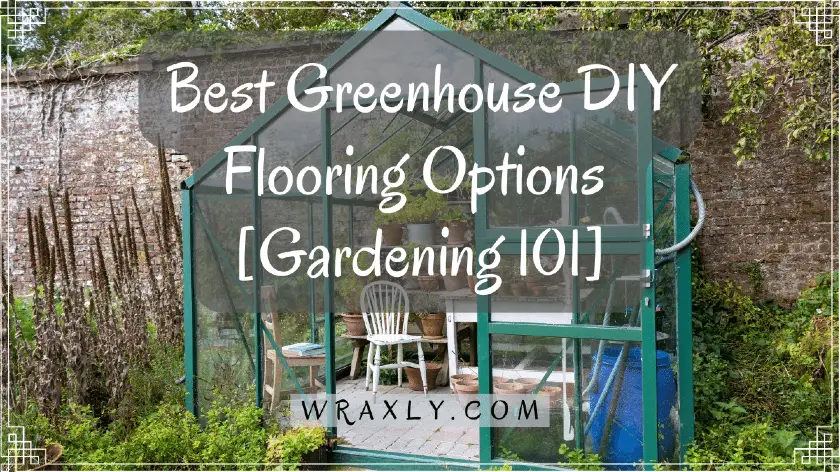As a gardener, it’s always interesting to see the latest statistics and trends in the industry. It’s also helpful to know how you compare to other gardeners in the United States. Here is a roundup of 145 gardening statistics and trends that you need to know.
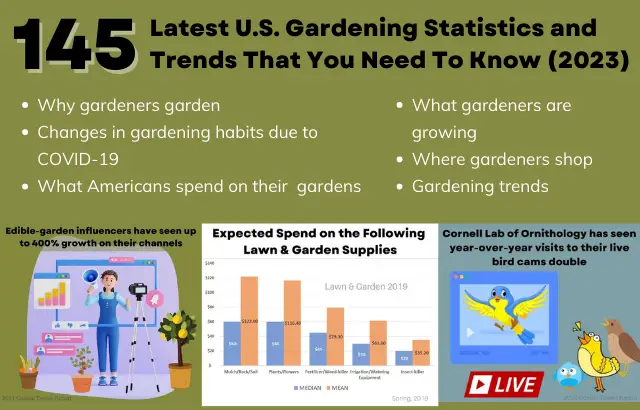
- Why Gardeners Garden
- Changes in Gardening Habits Due to COVID-19
- Where Gardeners Garden
- Gardening Participation in the U.S.
- How Much Time Do Gardeners Spend in Their Gardens?
- What Gardeners are Growing
- Where People Get Information About Gardening
- Gardening DIY (Not!)
- Where Gardeners Shop
- What American's Spend on Their Gardens
- What Equipment do Gardeners Own?
- Temperature Check – Challenges and Attitudes
- Gardening Trends
- Gardening is for the Birds
- Blog Post Sharing Policy
Why Gardeners Garden
71% feel it would benefit their mental health. (swnsdigital.com)
Seven in 10 Americans say gardening allows them to gain control over what they eat. (swnsdigital.com)
62% believe a garden would help improve their overall diet and wellness. (swnsdigital.com)
39% want to grow greens to save money. (swnsdigital.com)
37% are interested in gardening because it’s more affordable than grocery stores. (swnsdigital.com)
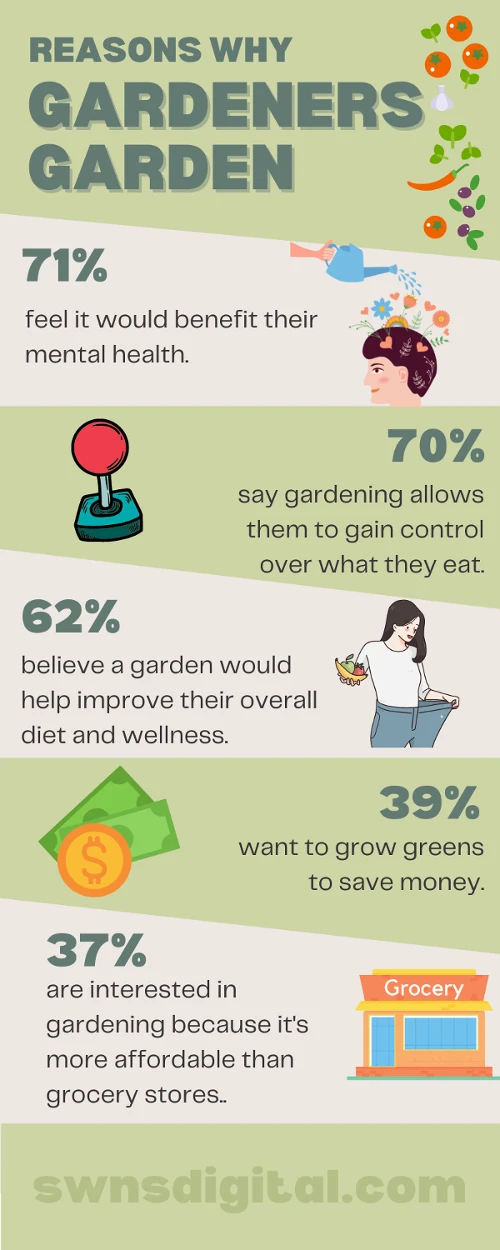
20% of baby boomers report gardening as a leisure pursuit. (4 Trends to Watch in the Gardening and Landscaping Industry)
Reasons for growing produce at home: saving money on produce (39%), reducing food waste (32%), and adding a new life skill (22%). (swnsdigital.com)
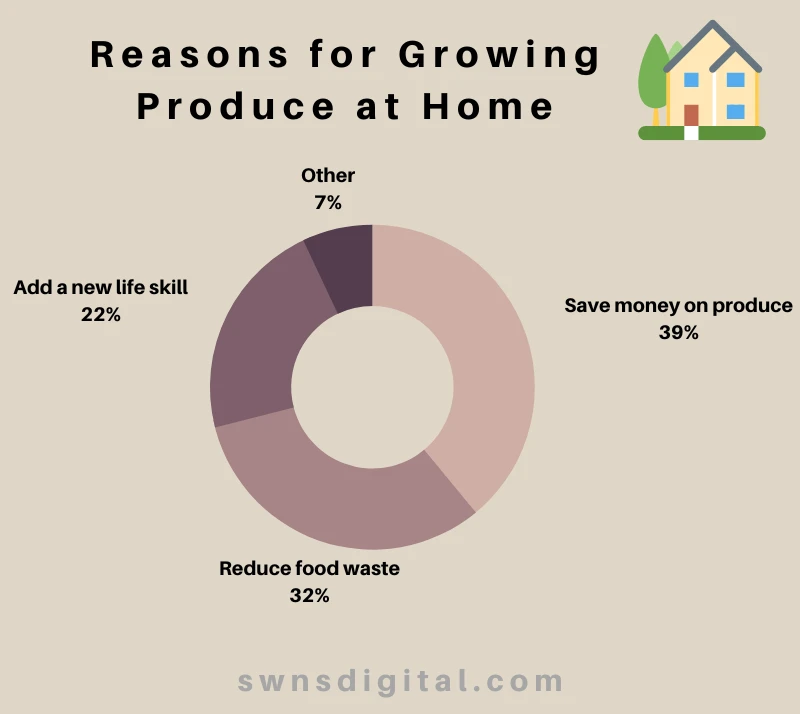
Six in 10 said that witnessing panic buying at the beginning of the pandemic inspired them to get their shovels out. (swnsdigital.com)
Changes in Gardening Habits Due to COVID-19
78% of independent garden centers have implemented curbside pickup since the COVID-19 outbreak. (2021 State of the Industry Report)
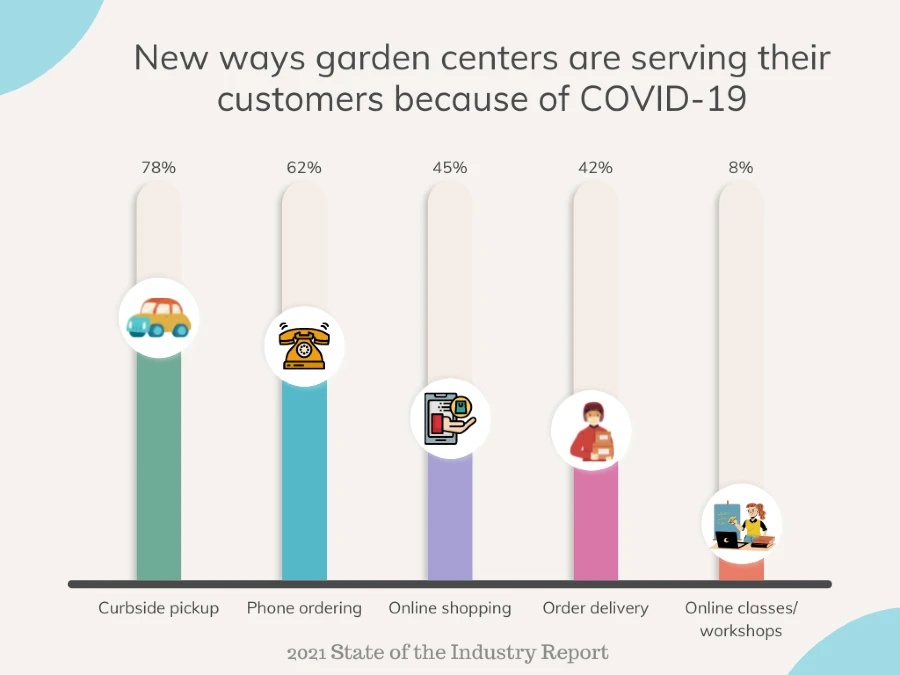
92% spent the same or more in 2021 due to COVID-10. (Axiom)
18.3 million additional people began gardening during COVID-19. (2022 Garden Trends Report)
75% of the new gardeners will keep growing post-pandemic according to McKinsey’s “stickiness test”. (2022 Garden Trends Report)
More than half (55%) of American adults is currently gardening or caring for their lawn during the COVID-19 outbreak, with an additional 20% saying they are “likely” to head outdoors and accept the green thumb challenge while in quarantine. (Scotts Miracle-Gro)
Among those gardening or caring for their lawn during the outbreak, the primary reasons for doing so are to stay busy (54%), to feel a sense of accomplishment (49%), to reduce stress (48%) and to access fresh food (33%). (Scotts Miracle-Gro)
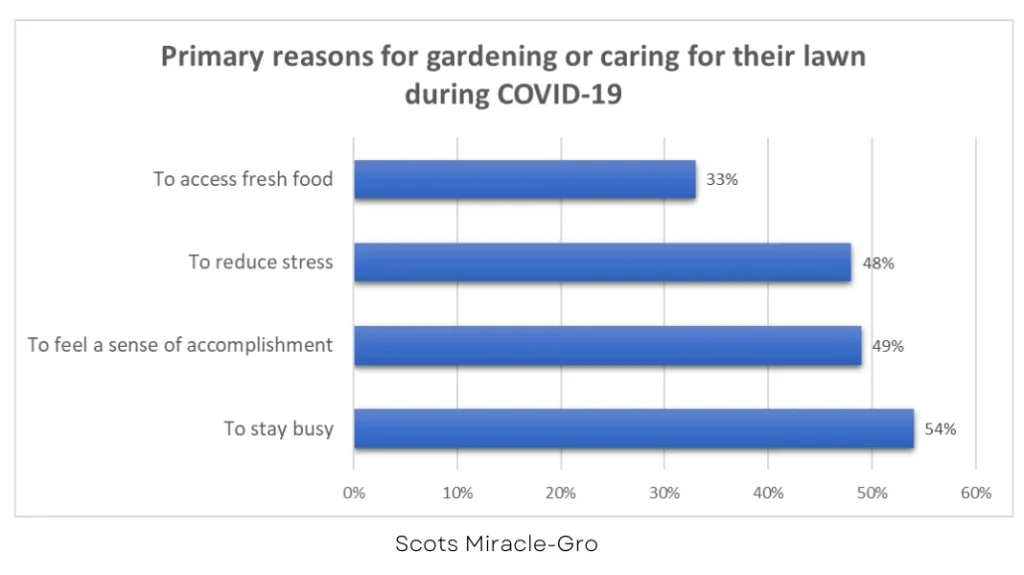
When asked about reasons for gardening and growing during the COVID-19 outbreak, Gen Zers (22%), millennials (21%) and Gen Xers (21%) are much more likely to cite reducing trips to the store as a reason for doing so than boomers (9%). (Scotts Miracle-Gro)
On average, American adults are spending two hours a day outside during the COVID-19 outbreak.Nearly half (49%) say they’re spending more time outside now than they did before the outbreak began. (Scotts Miracle-Gro)
76% of people who gardened during the pandemic said it started as a hobby. (swnsdigital.com)
Where Gardeners Garden
46% of food gardens include containers. (National Gardening Association. 2014. Garden To Table: Special Report.)
600 sq ft is the average food garden size. (coopeduplife.com)
96 sq ft is the median-sized food garden. (coopeduplife.com)
33 million (91%) grow food at home. (coopeduplife.com)
2 million (5%) grow food at a neighbors, family, or friends. (coopeduplife.com)
1 million (3%) grow food in a community garden. (coopeduplife.com)
1% grow food at other (unknown) locations. (coopeduplife.com)
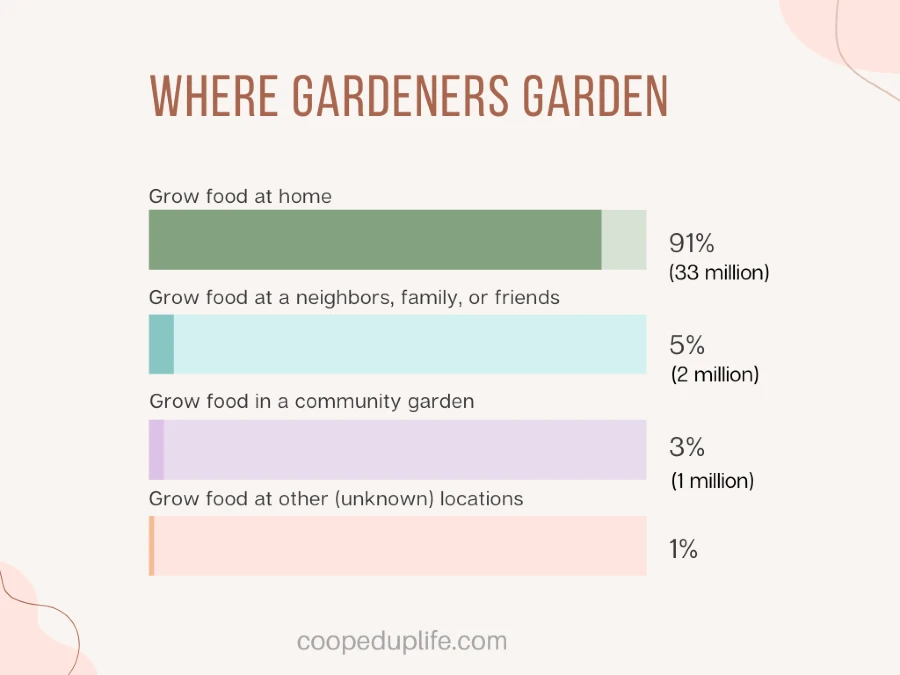
Tomatoes are the most popular vegetable to grow, followed by broccoli, green beans, and carrots. (coopeduplife.com)
10% of gardeners are between the ages of 45-64. (coopeduplife.com)
33% of gardeners have a college degree. (coopeduplife.com)
47% of gardeners have full-time employment. (coopeduplife.com)
22% of gardeners are retired. (coopeduplife.com)
Of Americans who have tried gardening over the past year, 65% made room in their backyard and 41% found nooks and crannies in their homes to grow a small herb garden. (swnsdigital.com)
67% of respondents 35 and under are interested in reducing the size of their lawn while the rest of their yard is planted with a wide variety of other plants. (2021 State of the Industry Report)
Container gardening is the #1 way 34-45-year-old gardeners prefer to garden. (2023 Garden Trends Report)
Gardening Participation in the U.S.
77% of all American households are gardening. (2021 State of the Industry Report)
35% of older Americans are gardeners, followed by 29% of 18 to 34-year-olds. (2021 State of the Industry Report)
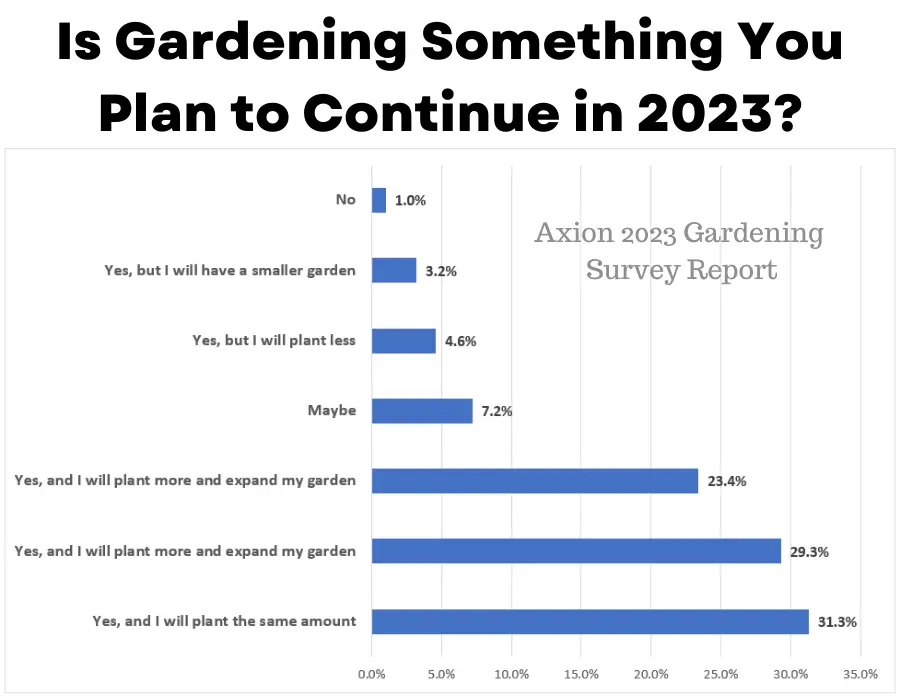
74.3% of millennials (and 59.5% of all respondents) reported an increased interest in gardening. (Axiom)
One in 3 households (35%) are now growing their own food. Highest overall participation and spending levels seen in the United States in a decade. (National Gardening Association. 2014. Garden To Table: Special Report)
63% increase in millennial participation in food gardening. (National Gardening Association. 2014. Garden To Table: Special Report)
31.9 million U.S. households participated in vegetable gardening in 2019. (Statista.com)
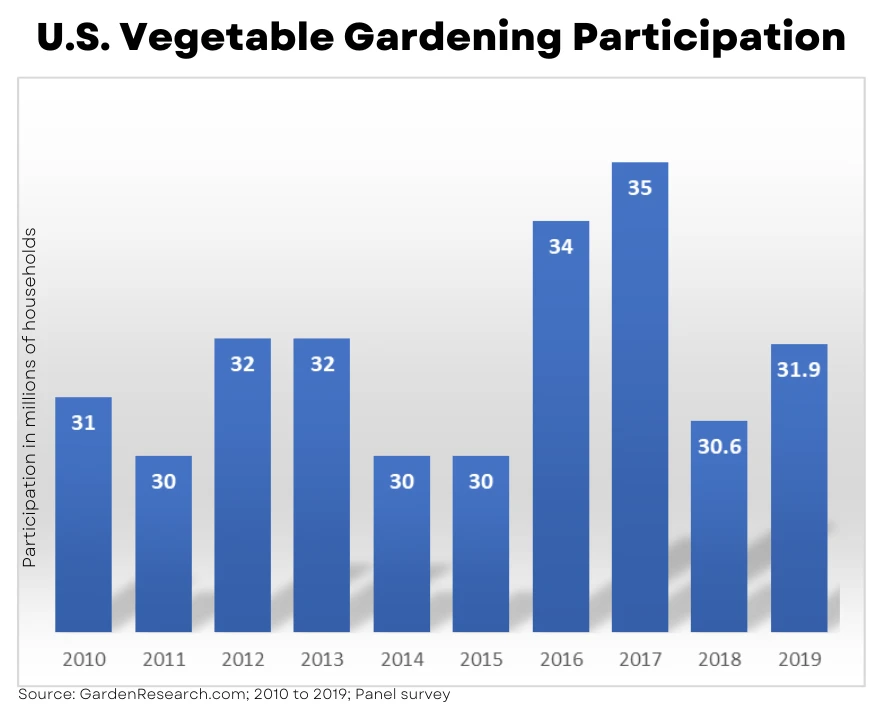
29% increase in food gardening among urban households. (National Gardening Association. 2014. Garden To Table: Special Report)
87% participation rate in food gardening in households that make $75,000 and up. (National Gardening Association. 2014. Garden To Table: Special Report)
21.2 million U.S. households participated in container gardening activities in 2019. (Statista.com)
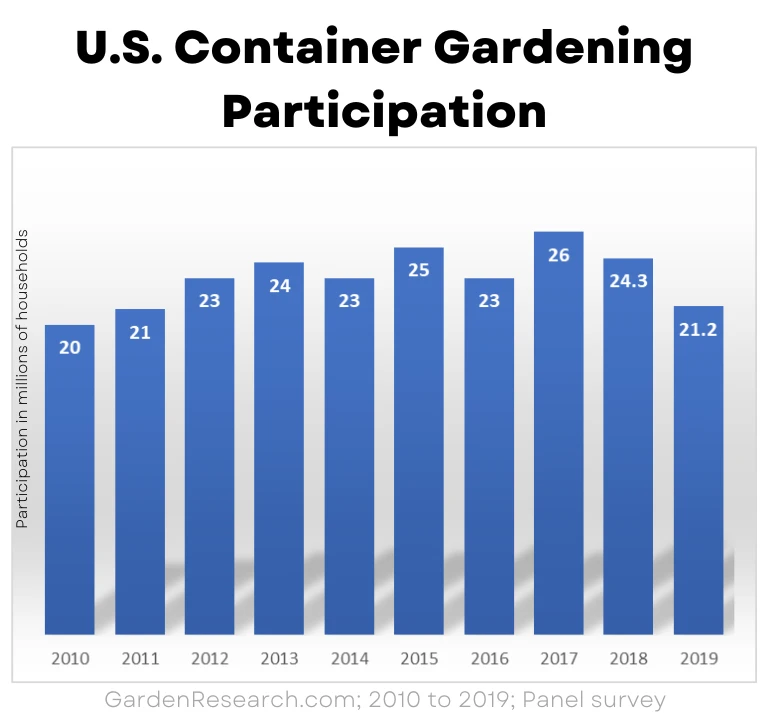
50% of all food gardening households (21 million) lived in the suburbs in 2013. (National Gardening Association. 2014. Garden To Table: Special Report)
34% of all food gardening households (14 million) in 2013 have a high school education, up 75% from 8 million in 2008. (National Gardening Association. 2014. Garden To Table: Special Report)
Eight in 10 Americans have grown their own produce over the past year. (swnsdigital.com)
35.8 million U.S. households participated in flower gardening activities in 2019. (Statista.com)
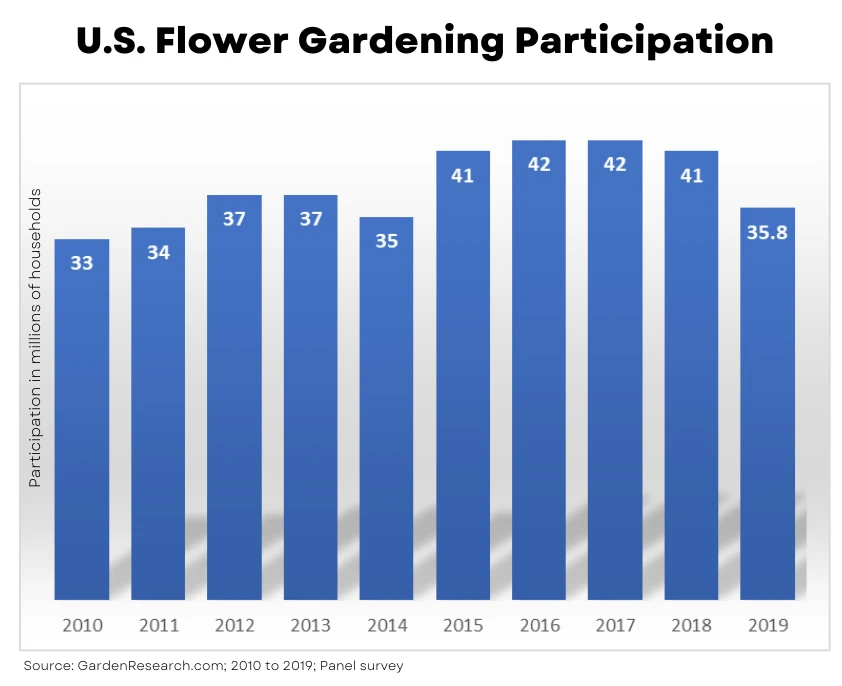
In 2008 there were 36 million gardens in the US, and by 2009 there were 43 million houses with gardens. (yourgreenpal.com)
Since 2018, gardening has become increasingly popular with millennials. Millennials now make up approximately 29% of the gardening population. (Gardening Trends and Statistics)
37% of Millennials and 28% of Baby Boomers are already growing herbs indoors. (2017 Garden Trends Report)
62.4% of gardeners plan to plant more in 2022. (Axiom)
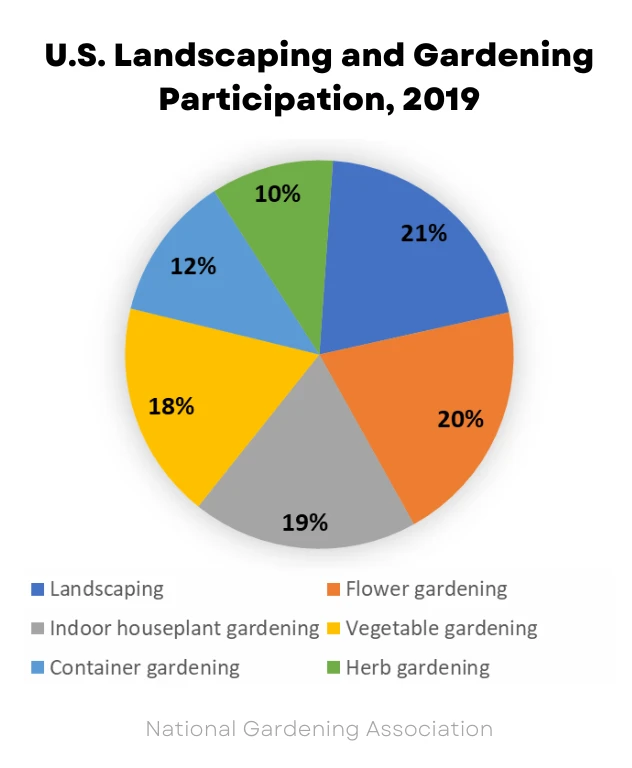
60% of people around the world grow vegetables or flowers indoors. (backtotheroots.com)
How Popular is Gardening – By Age Groups
11% are 18-29-year-olds, 21% are 30-49-year-olds, 29% are 50-64 year-olds, and the other 39% are predominately 65 years and older or younger than 18. In terms of gender, 54% percent of gardeners are female. (2018 National Gardening Survey)
In the US about 25% of households garden. In the west 23% of Americans Garden, in the mid-west 26%, in the northeast 22%, and in the south 29% of Americans gardens. (yourgreenpal.com)
How Much Time Do Gardeners Spend in Their Gardens?
More than half of American adults are spending two additional hours a day outside during quarantine than before the outbreak began. (2021 Garden Trends Report)
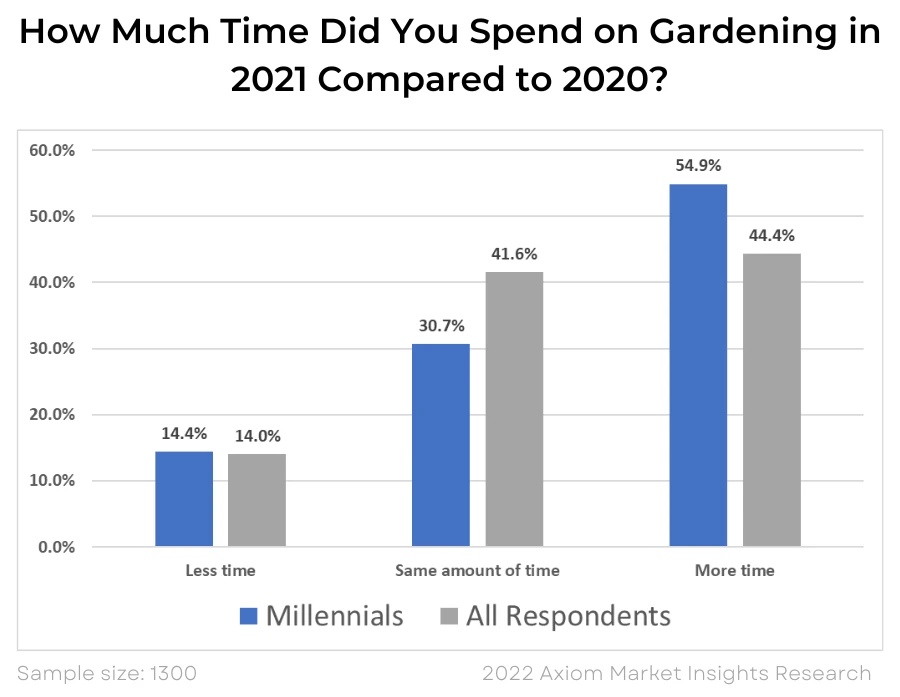
The average home gardener will spend about 5 hours a week in a garden. These tasks will include weeding, planting seeds, watering, and moving dirt. (yourgreenpal.com)
Average hours per day for persons who engaged in lawn and garden care, Men: 2.38 hours, women: 1.6 hours (American Time Use Survey – 2021 Results)
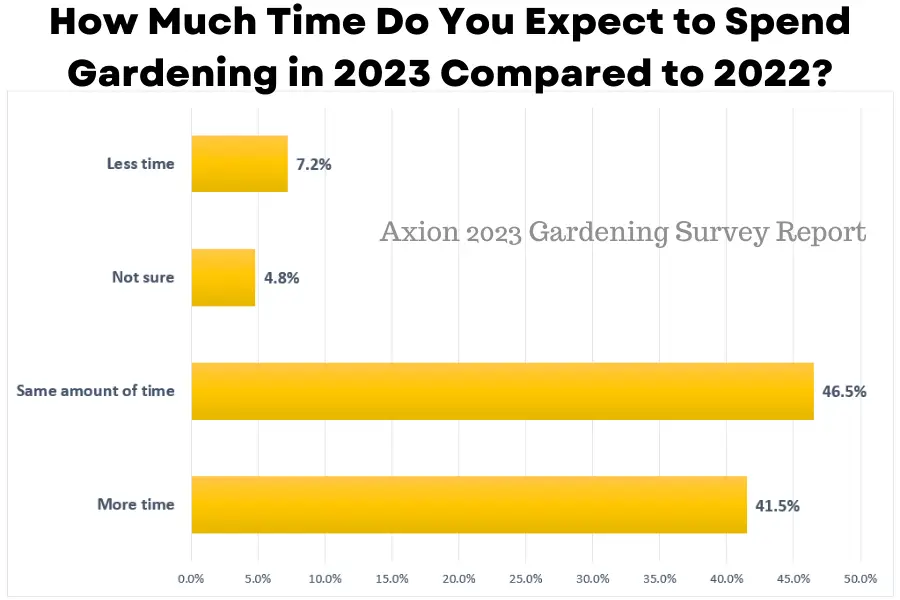
What Gardeners are Growing
Two thirds (67%) of adults are growing or plan to grow edible plants, including vegetables (52%), herbs (33%), and fruits (31%). (Scotts Miracle-Gro)
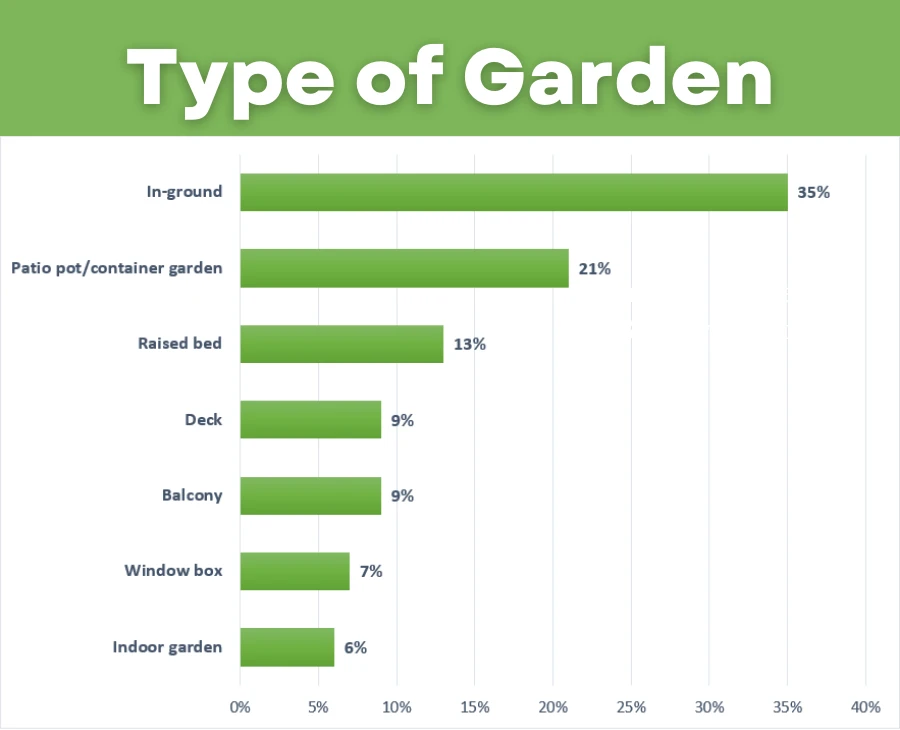
71.86% of gardeners grow flowers. 65.77% grow vegetables. (Axiom)
54.49% of respondents plan to create vegetable gardens in 2022. (Axiom)
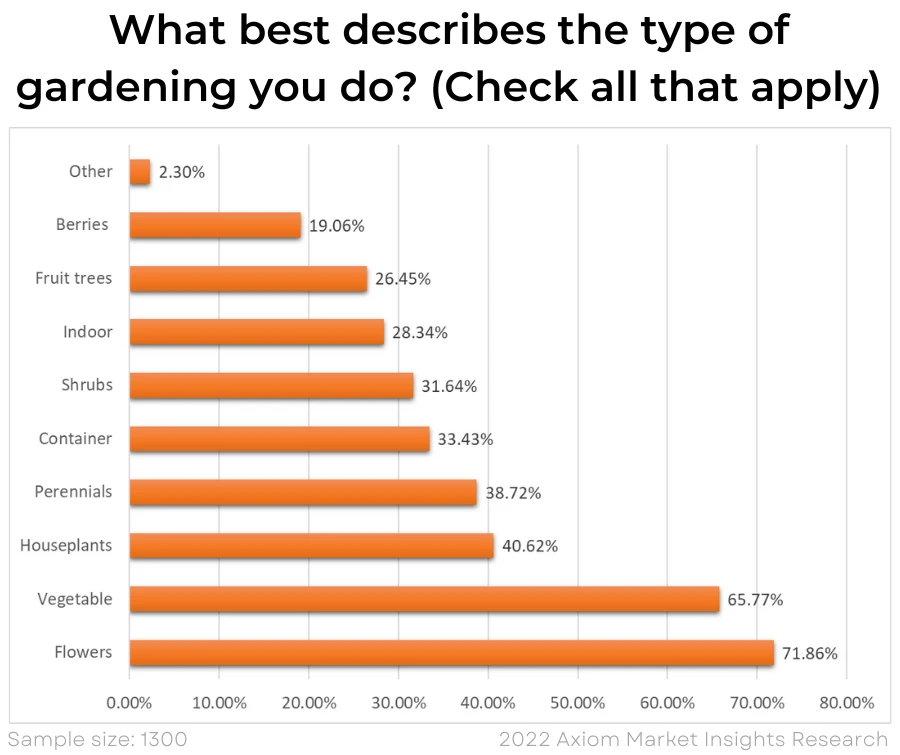
$2000. The amount a skilled gardener can grow in produce per year on a ten-foot by ten-foot plot with minimal inputs. (How to Grow More Vegetables)
86% of gardeners eat the fruits of their labor. (swnsdigital.com)
Of those who’ve dabbled in gardening, 76% claim it’s their new hobby, and 86% have eaten the fruits of their labor. (swnsdigital.com)
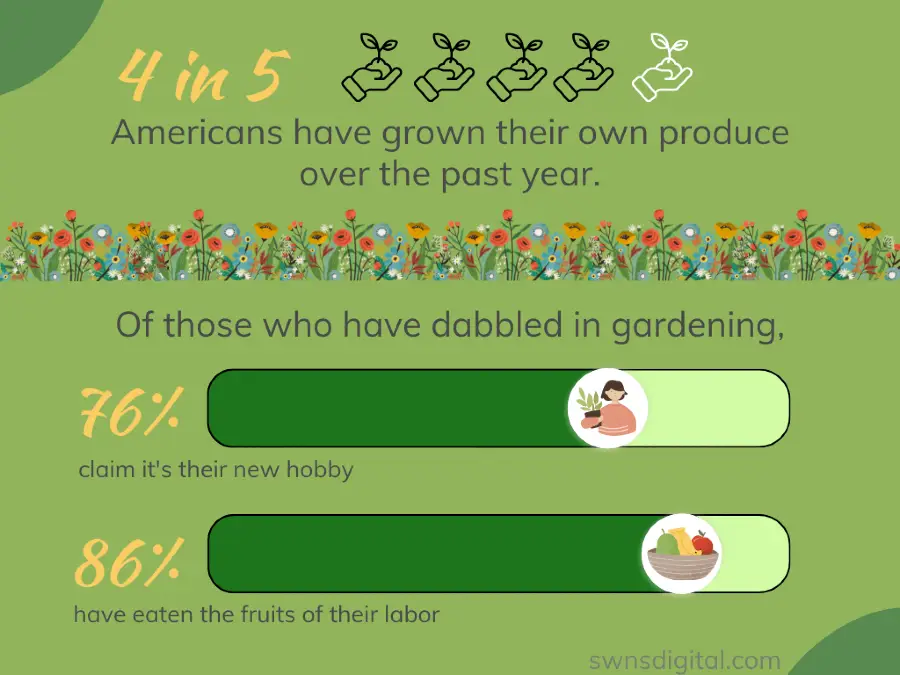
On average, home vegetable gardens produce $677 worth of fruits and vegetables, beyond the cost of $238 worth of materials and supplies. (What are the Economic Costs and Benefits of Home Vegetable Gardens?)
32% of Americans tried to grow more produce from what they’ve purchased at a grocery store. (swnsdigital.com)
What’s on gardener’s “to grow” list: tomatoes (71%), herbs (52%), flowers (49%), cucumbers (47%). (swnsdigital.com)
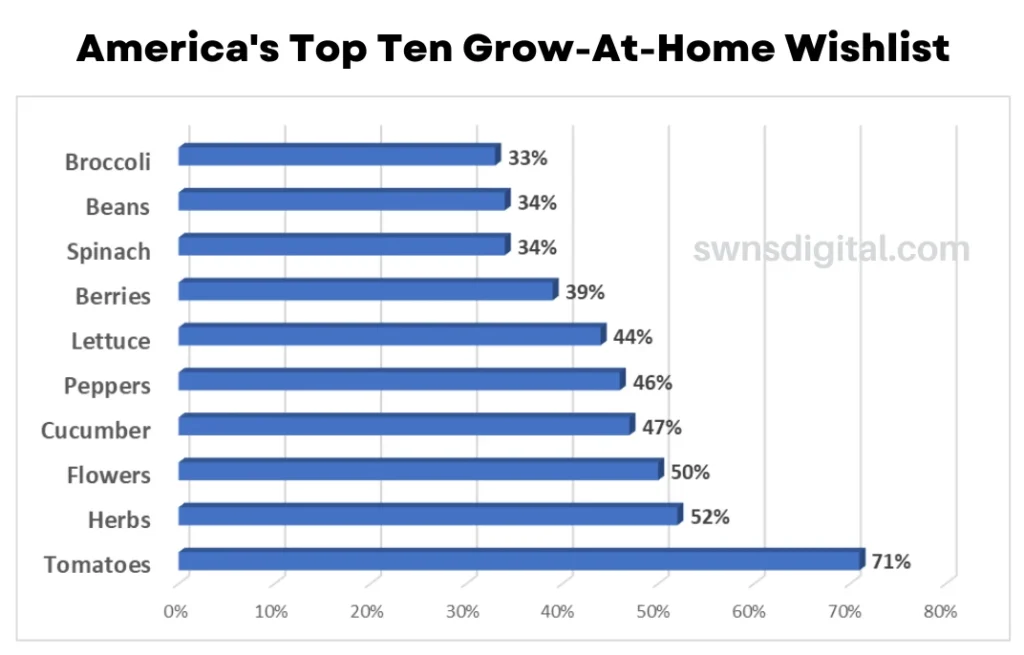
76% of all households with a food garden grew vegetables. (National Gardening Association. 2014. Garden To Table: Special Report)
Most Common Fruits Grown at Home in 2020
Although growing fruit varies by region, here are the most commonly grown fruits in the United States: (Gardening Trends and Statistics)
- Blackberries
- Raspberries
- Strawberries
- Blueberries
- Apple, peach, and cherry trees
Most Popular Outdoor Plants and Flowers for 2020
Here are some of the trendiest, most popular outdoor plants and flowers people can’t stop snapping pictures of and growing: (Gardening Trends and Statistics)
- Perennials: Irises, lavender, Japanese Sedge, daylilies, peonies, black-eyed Susans, thyme, Lamb’s ear, chamomile, hostas, catmint, ornamental grasses, Russian sage, dianthus, baptisa
- Annuals: Lantana, begonias, cosmos, dahlias, geraniums, impatiens, marigold, pansies, petunias, snapdragons, sunflowers
- Flowering shrubs: hydrangeas, Rose of Sharon, forsythia, hibiscus, rhododendron, butterfly bush
- Trees: citrus, magnolia, dogwood, cherry, oak, maple, pine
Where People Get Information About Gardening
The top sources for advice include home and garden websites (44%), their family (40%) and experts at local garden centers or hardware stores (37%). But nearly 1 in 5 (19%) of those who get advice are turning to mobile apps, including 29% of millennials and 25% of Gen Zers. (Scotts Miracle-Gro)
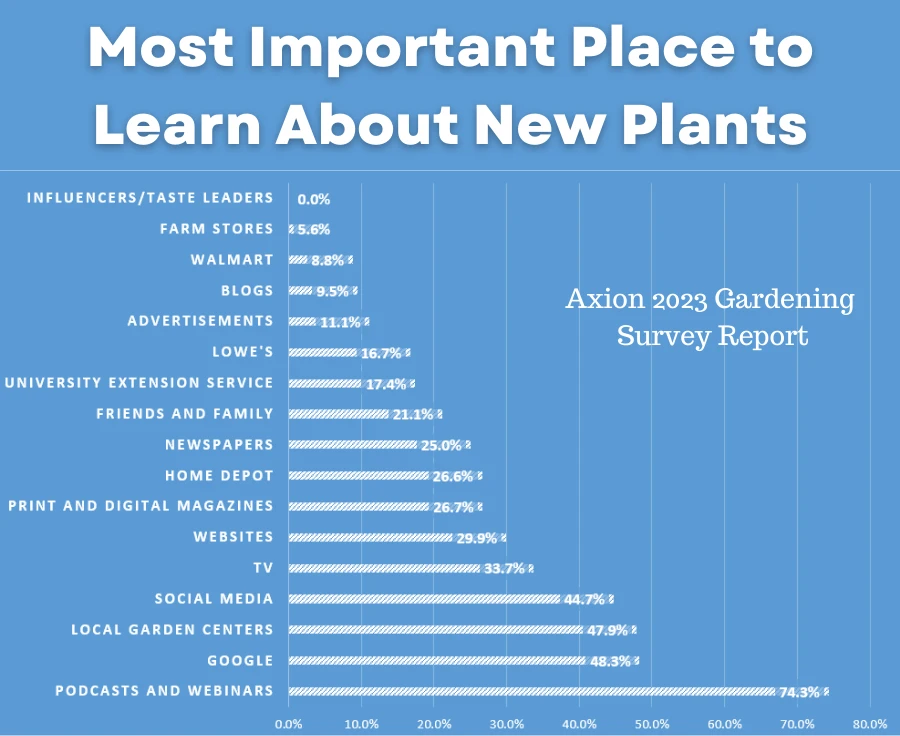
40% of gardeners look to retailers to discover new garden products. (Axiom)
33.5% of gardeners learn about new plants and gardening supplies from Facebook. (Axiom)
85% purchase products or services after seeing them reviewed on social. (2023 Garden Trends Report)
79% take gardening advice from online sources. (2023 Garden Trends Report)
Gardening DIY (Not!)
40% of Americans with a yard hired professionals for lawn or landscape work in 2017. Top services used among Americans who have hired a lawn/landscaping professional in the past 12 months include tree care (51%), mowing (50%), lawn pest control (46%), and weed prevention and control (42%). (NALP)
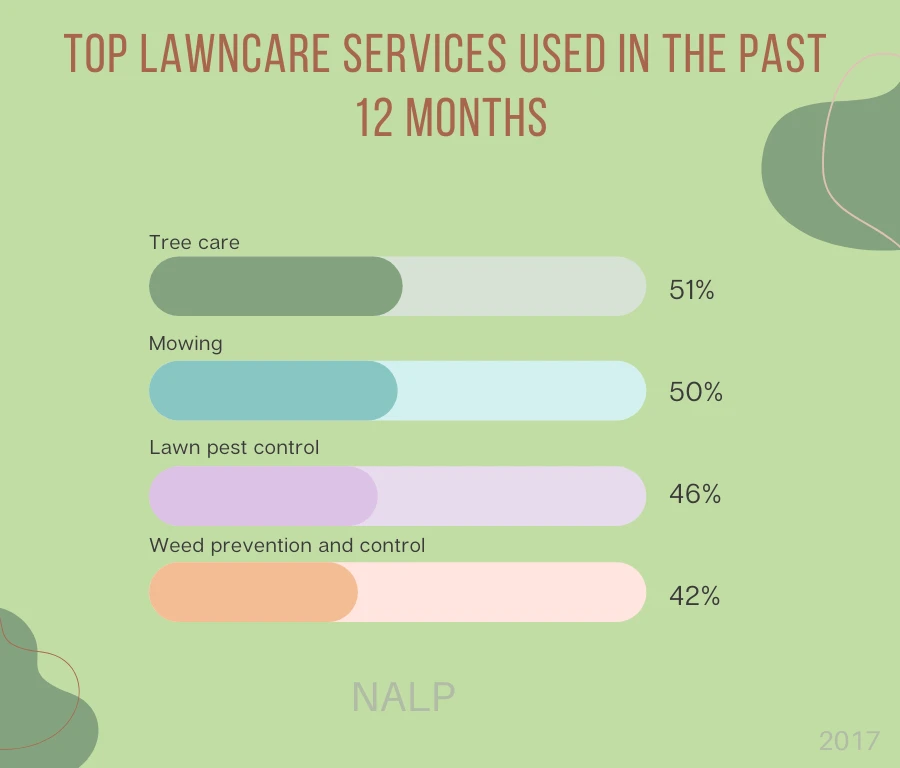
Married individuals are more likely than those who aren’t married to have invested in lawn care and/or landscape maintenance services in past 12 months (45% vs. 33%). (NALP)
Sixty-two percent of those who didn’t hire a lawn/landscape professional in the past 12 months say the costs is too high, while nearly half (49%) say they enjoy caring for their lawn themselves and 43% believe their yard is fine as is. (NALP)
For those who have hired professional help, 52% did so to help their lawn/landscape look better, while 41% wanted to save time and 30% wanted to enjoy their yard more. (NALP)
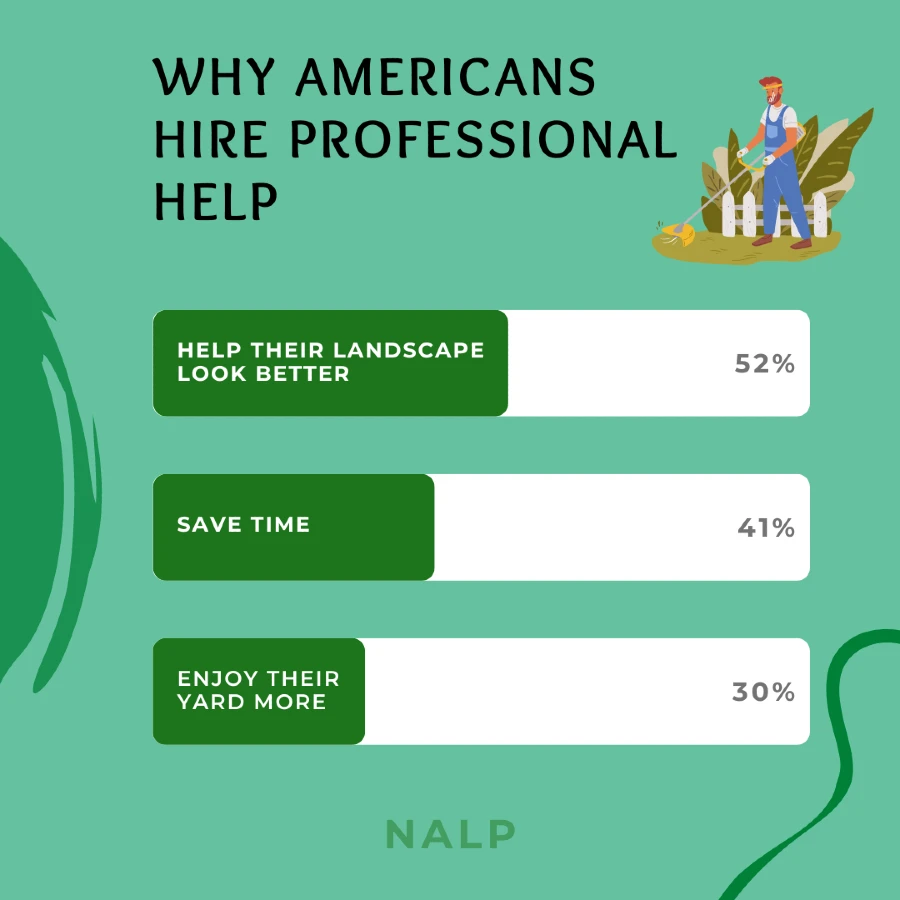
The landscaping and gardening service market is projected to register a compounding annual growth rate of 4.2% over the next 5 years (2022 to 2027). (LANDSCAPING AND GARDENING SERVICE MARKET – GROWTH, TRENDS, COVID-19 IMPACT, AND FORECASTS (2022 – 2027))
Where Gardeners Shop
46 percent of U.S. lawn and garden retail sales were made at home centers in 2019. (Statista.com)
$44.5 billion U.S. dollars. The total value of the U.S. lawn and garden retail outlet sales in 2019. (Statista.com)
What American’s Spend on Their Gardens
Independent garden centers experienced a 22% growth in sales for houseplants/tropicals/succulents in spring of 2021 compared to a year earlier. (2021 State of the Industry Report)
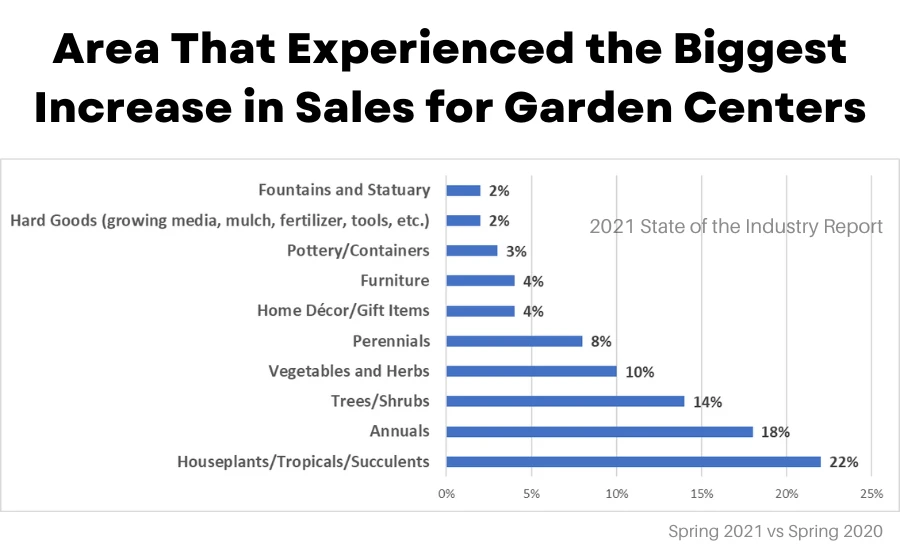
$47.8 billion. The amount American gardeners spent on lawn and garden retail sales in 2020. (Garden Media. 2021. Garden Media’s 2021 Garden Trends Report: The Great Reset.)
$503. The amount the average household spent in 2020 (up nearly $100 over the previous year) on gardening goods. (Garden Media. 2021. Garden Media’s 2021 Garden Trends Report: The Great Reset.)
65% more millennials are visiting independent gardening centers in the past 18 months. (2021 State of the Industry Report)
Independent garden centers experienced a 9% decrease in sales for vegetables and herbs in spring of 2021 compared to a year earlier. (2021 State of the Industry Report)
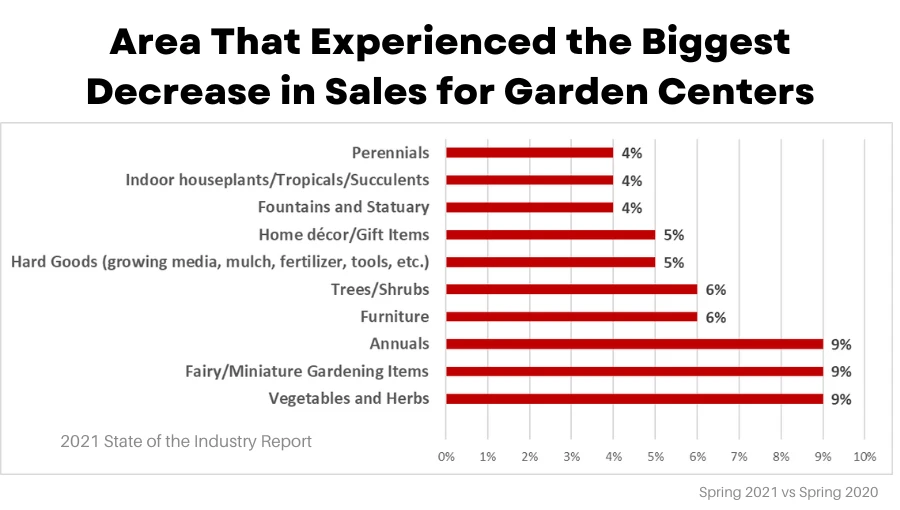
The 35- to 44-year-old age bracket had the highest mean of spending ($608.54) of all age groups in 2019. (Garden Media. 2021. Garden Media’s 2021 Garden Trends Report: The Great Reset.)
27% of plant purchases were made at independent garden/nursery centers. (Axiom)
25.7% of garden supply purchases were made at Home Depot Garden Centers. (Axiom)
28.34% of gardeners expect to spend more money on gardening in 2022. (Axiom)
3.12 million Americans bought Black & Decker in 2020. – Brands of lawn and garden tools bought in the last 12 months in the U.S. 2020. (Statista)
In 2020, the country’s average expenditure on gardening/lawn care services amounted to 170.77 U.S. dollars per consumer unit. (U.S. household expenditure on gardening/lawn care services 2007-2020)
The total nationwide spend on gardening is 2.5 billion dollars. The average garden yields $600 of produce in a year, minus the spend per household of $70. The average household returns $530 each year from their garden. (yourgreenpal.com)
Retail-level sales of lawn and garden consumables are expected to increase 2.7% per year from $14 billion in 2017 to $16 billion in 2022. (Lawn and Garden Consumables: Consumer Insights)
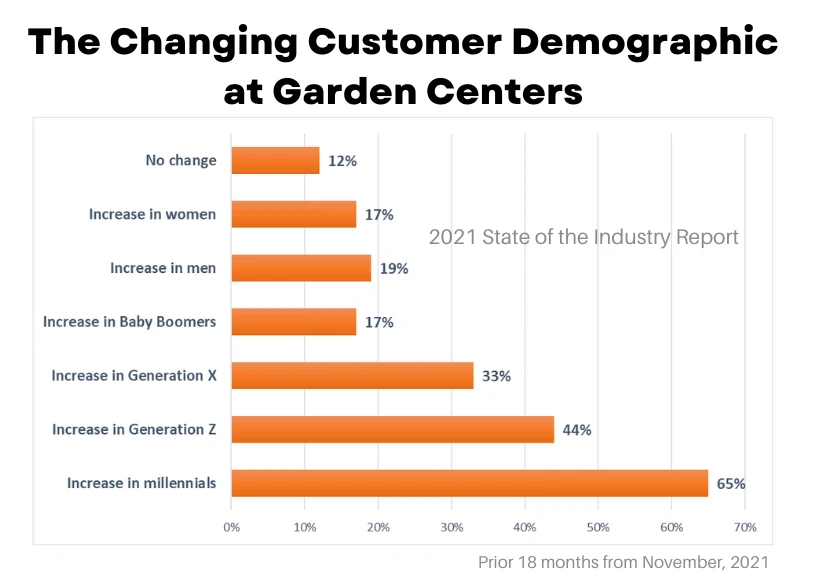
Retails sales of building material, nursery, garden equipment, & garden store sales increased 8.6% between spring 2019 and spring 2020 (U.S. Census bureau, Advance Monthly Retail Trade Survey, June 16, 2020)
The global gardening pots market size was valued at USD 1.7 billion in 2018. (Gardening Pots Market Size, Share & Trends Analysis Report)
29.1%. The amount the average consumer household spent on lawn and garden supplies in 2020. (2021 Lawn & Garden Industry Deep Dive: Data, Stats, & Trends for Brands)
$102 billion. The amount the home and garden B2C ecommerce market is expected to grow from 2020 to 2024. (2021 Lawn & Garden Industry Deep Dive: Data, Stats, & Trends for Brands)
$155.07. The amount the average consumer household spent on lawn and garden supplies in 2020 (an increase of 29.1%).(2021 Lawn & Garden Industry Deep Dive: Data, Stats, & Trends for Brands)
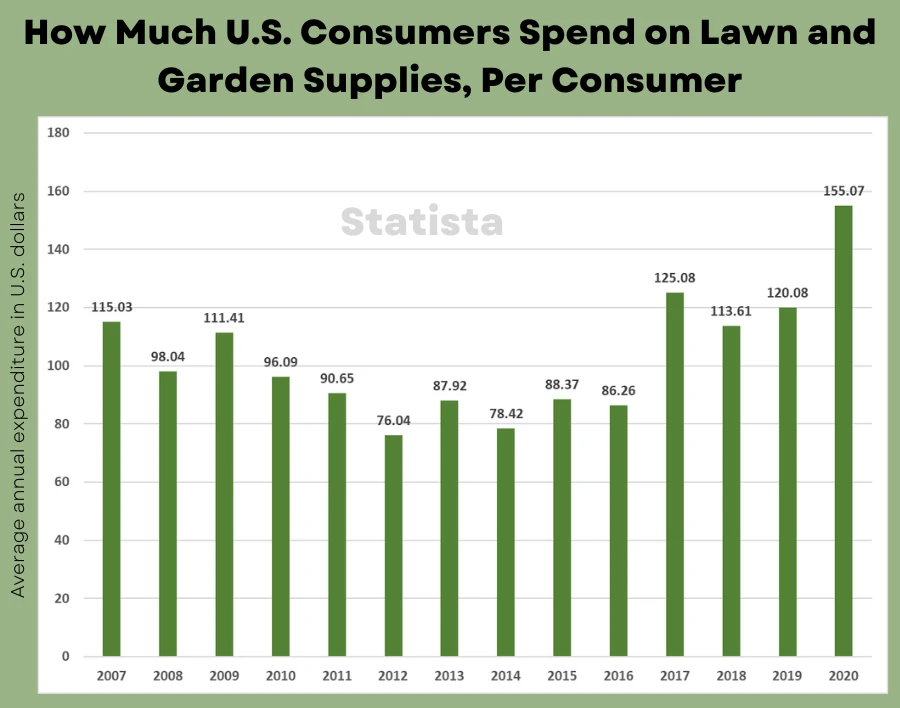
55%. The amount order volume for home and garden industry brands increased in April 2020. (2021 Lawn & Garden Industry Deep Dive: Data, Stats, & Trends for Brands)
Consumer spending on gardening and lawn care services grew 8.39% to $170.77 per household in 2020. (2021 Lawn & Garden Industry Deep Dive: Data, Stats, & Trends for Brands)
North America accounts for 35% of global revenue for home and garden pesticides. (2021 Lawn & Garden Industry Deep Dive: Data, Stats, & Trends for Brands)
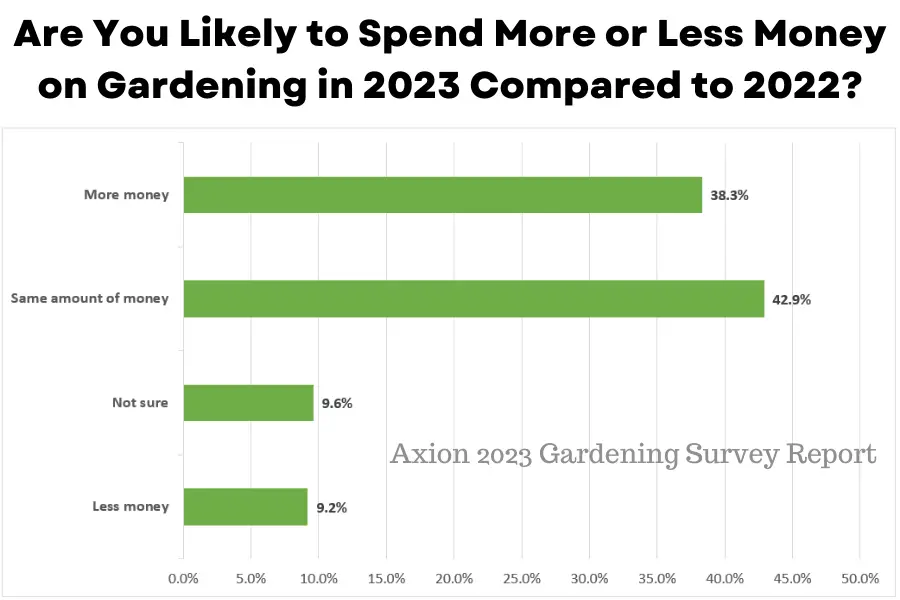
Nursery and garden stores are a $42 billion industry. There are 22,499 nursery/garden stores in the U.S. (Nursery & Garden Stores Industry in the US – Market Research Report)
428th largest. The market size of the Plant & Flower Growing industry in the U.S. (Ibisworld.com)
Revenue for lawn and outdoor equipment stores grew 5.6% in 2020 and is expected to grow 2.3% to reach $10.1 billion in 2021. (2021 Lawn & Garden Industry Deep Dive: Data, Stats, & Trends for Brands)
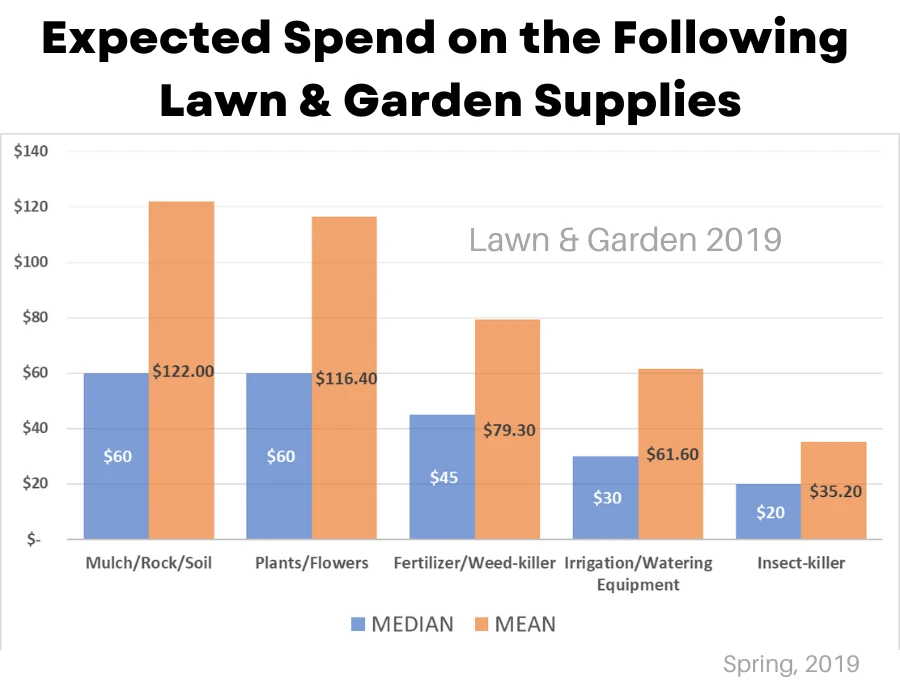
24% of homeowners who plan to make lawn and garden purchases are completely or very likely to make at least some purchases online/in-app. (Lawn & Garden 2019)
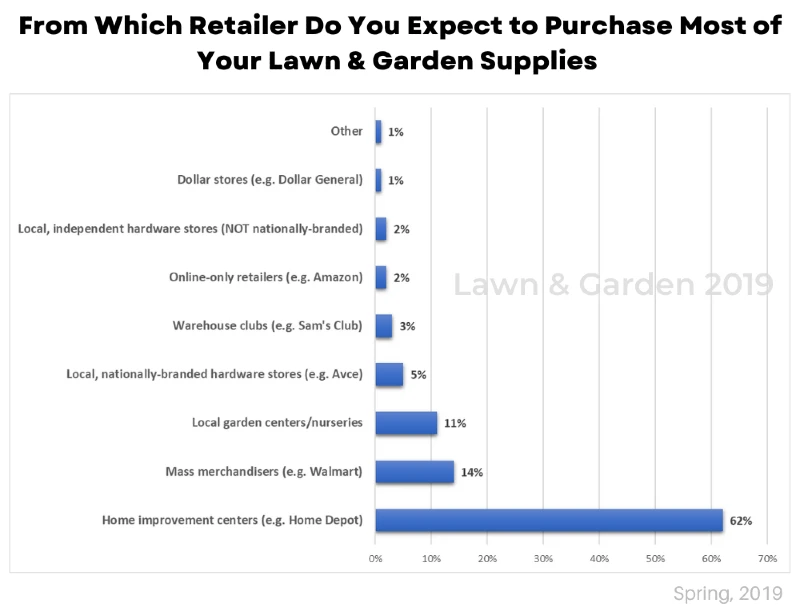
What Equipment do Gardeners Own?
100.58 million Americans owned Craftsman lawn and garden equipment in 2020. (Statista: Brands of lawn and garden tools owned in the U.S. 2020)
150.41 million Americans owned a leaf blower or vacuum in 2020. Leaf blowers and vacuums are the most common type of lawn and garden tools Americans own, followed by hedge trimmers and fertilizer spreaders. 69.07 million Americans own riding lawn mowers, with 102.85 owning walk-behind mowers. (Statista: Possession of lawn and garden tools in the U.S. 2012-2020)
223.7 million Americans owned lawn and garden equipment in 2019. That number grew 2.27% to 228.7 million in 2020 and is expected to grow to 237.2 million by 2024. (2021 Lawn & Garden Industry Deep Dive: Data, Stats, & Trends for Brands)
Temperature Check – Challenges and Attitudes
Weeds, insects, and soil conditions top the list of the most common challenges that gardeners face. These top changes have remained constant since 2012. (National Gardening Survey 2018 Edition)
What do people dislike about gardening? The top 3 complaints about gardening are that it takes too much work, costs too much and takes up too much time. (National Gardening Survey 2018 Edition)
84% of gardeners felt successful in their garden in 2021. (Axiom)
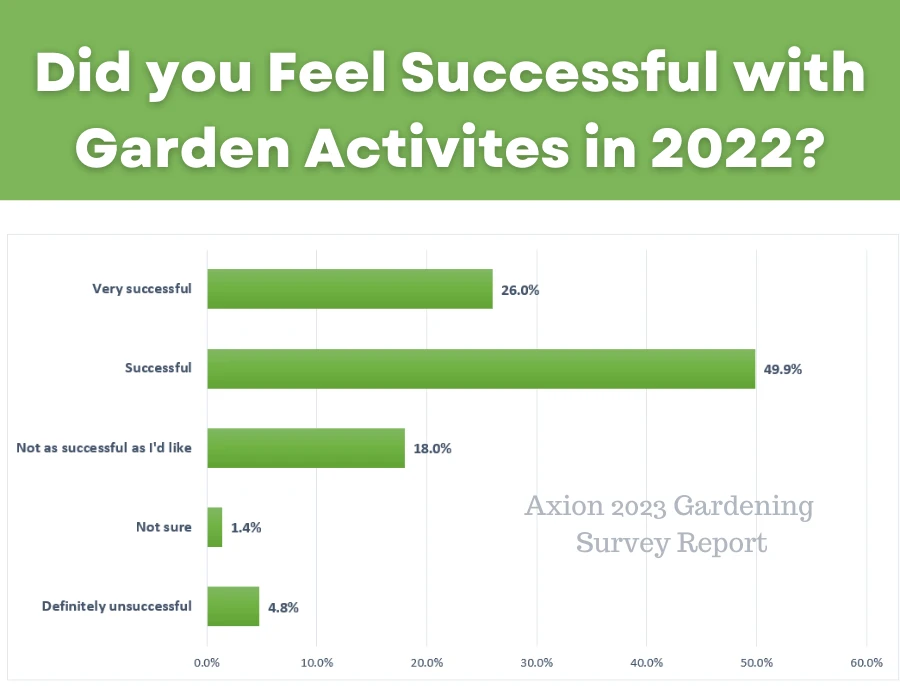
68% of Americans believe more people should consider gardening to have greater control over their food. (swnsdigital.com)
Of those who haven’t attempted to garden, 55% wish they could learn how but 42% are worried they wouldn’t know what to do. (swnsdigital.com)
Seven in 10 (72%) see a lack of space in their home as a barrier to begin or expand their gardening hobby. (swnsdigital.com)
Gardening Trends
Google searches for lawn and garden peaked from May 6 to May 12, 2018 and Google searches for gardening peaked from April 29 through May 5, 2018.
350% increase in searches for hanging plants on Pinterest in 2018. (Lawn & Garden Trends for 2019)
200% increase in hydrangea landscaping searches on Pinterest in 2018. (Lawn & Garden Trends for 2019)
200% increase in landscaping front yard on a budget searches on Pinterest in 2018. (Lawn & Garden Trends for 2019)
Edible-garden influencers have seen up to 400% growth on their channels. (2021 Garden Trends Report)
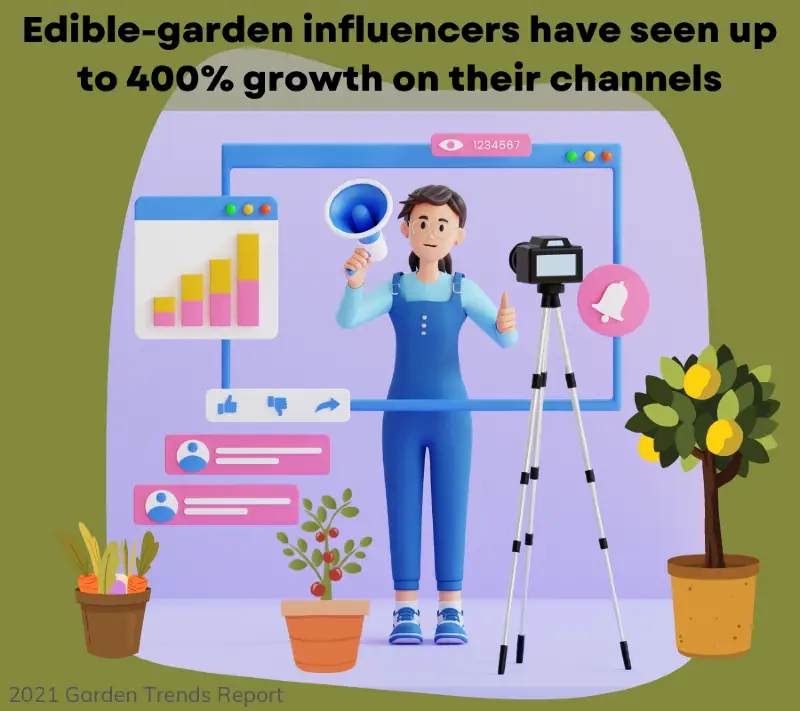
50% increase in planting succulents searches on Pinterest in 2018. (Lawn & Garden Trends for 2019)
-0.5%. Expected growth rate of the Plant & Flower Growing industry in the U.S. in 2022. (Ibisworld.com)
0.8%. Amount the Plant & Flower Growing industry in the U.S. has grown between 2017 and 2022. The market size of the Plant & Flower Growing industry in the US grown slower than the economy overall. (Ibisworld.com)
The raised garden beds market is expected to witness market growth at a rate of 6.50% in the forecast period of 2022 to 2029 and is further estimated to reach USD 2,467.5 million by 2029. (Global Raised Garden Beds Market – Industry Trends and Forecast to 2029)
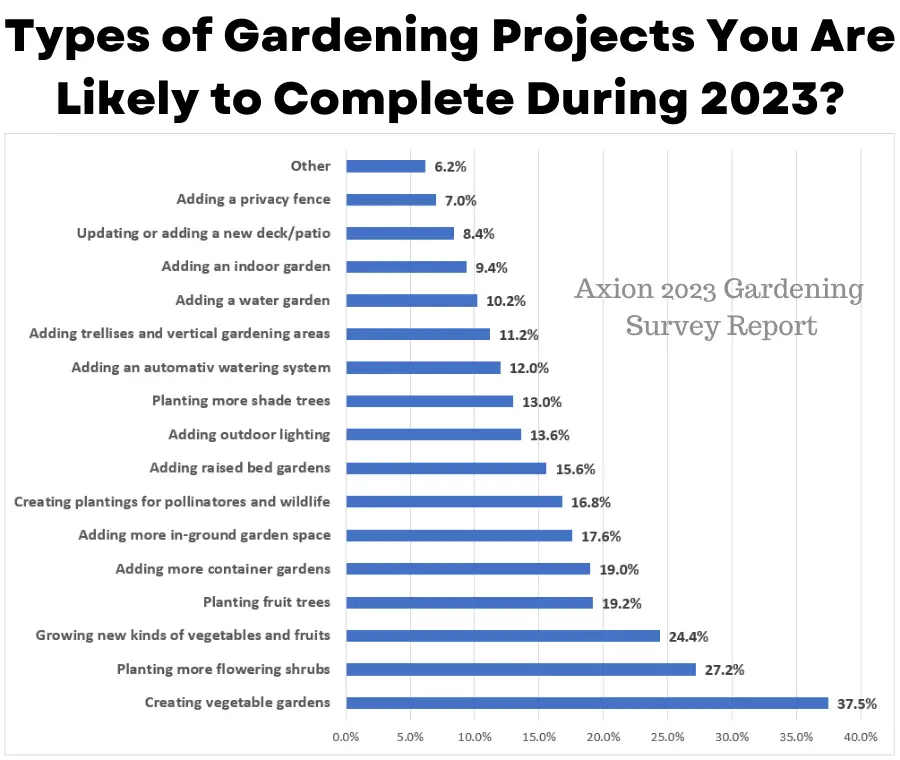
8 in 10 young people think gardening is “cool” and more than half would rather go to a garden center than a nightclub. (2022 Garden Trends Report)
78% of gardeners believe you don’t need a big outdoor area to garden. (2022 Garden Trends Report)
Global home and garden pesticides market is expected to reach $10.88 billion by 2028. (2021 Lawn & Garden Industry Deep Dive: Data, Stats, & Trends for Brands)
You may also be interested in… UK Gardening statistics for 2022
Gardening is for the Birds
Cornell Lab of Ornithology has seen year-over-year visits to their live bird cams double. (2022 Garden Trends Report)
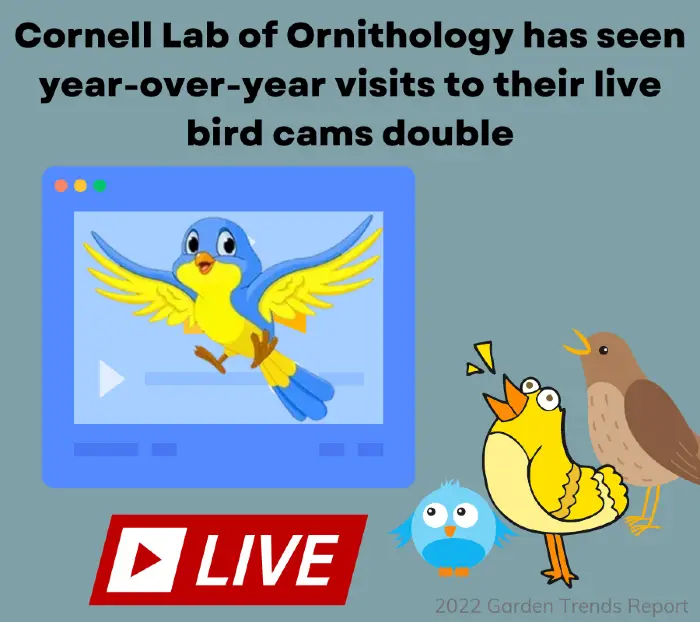
81%. The amount Audubon’s Bird Guide App grew from 2019 to 2020. (2022 Garden Trends Report)
$2.2 billion. Projected sales of feeders and feed in 2021. (2022 Garden Trends Report)
67.2 million households in 2020 purchased at least one plant because it benefited pollinators or birds. (2022 Garden Trends Report)
People with children are more likely to garden for birds. (2022 Garden Trends Report)
You may also be interested in… 61 Latest Halloween Statistics in the U.S. (2022)
Blog Post Sharing Policy
You have our permission to share any of these statistics or charts as long as you include a dofollow link back to this page.

Darrell has a passion for gardening that he inherited from his father. Go here to read more about the influence his father played in his love for gardening. If you want to send Darrell a quick message, then visit his contact page here.



